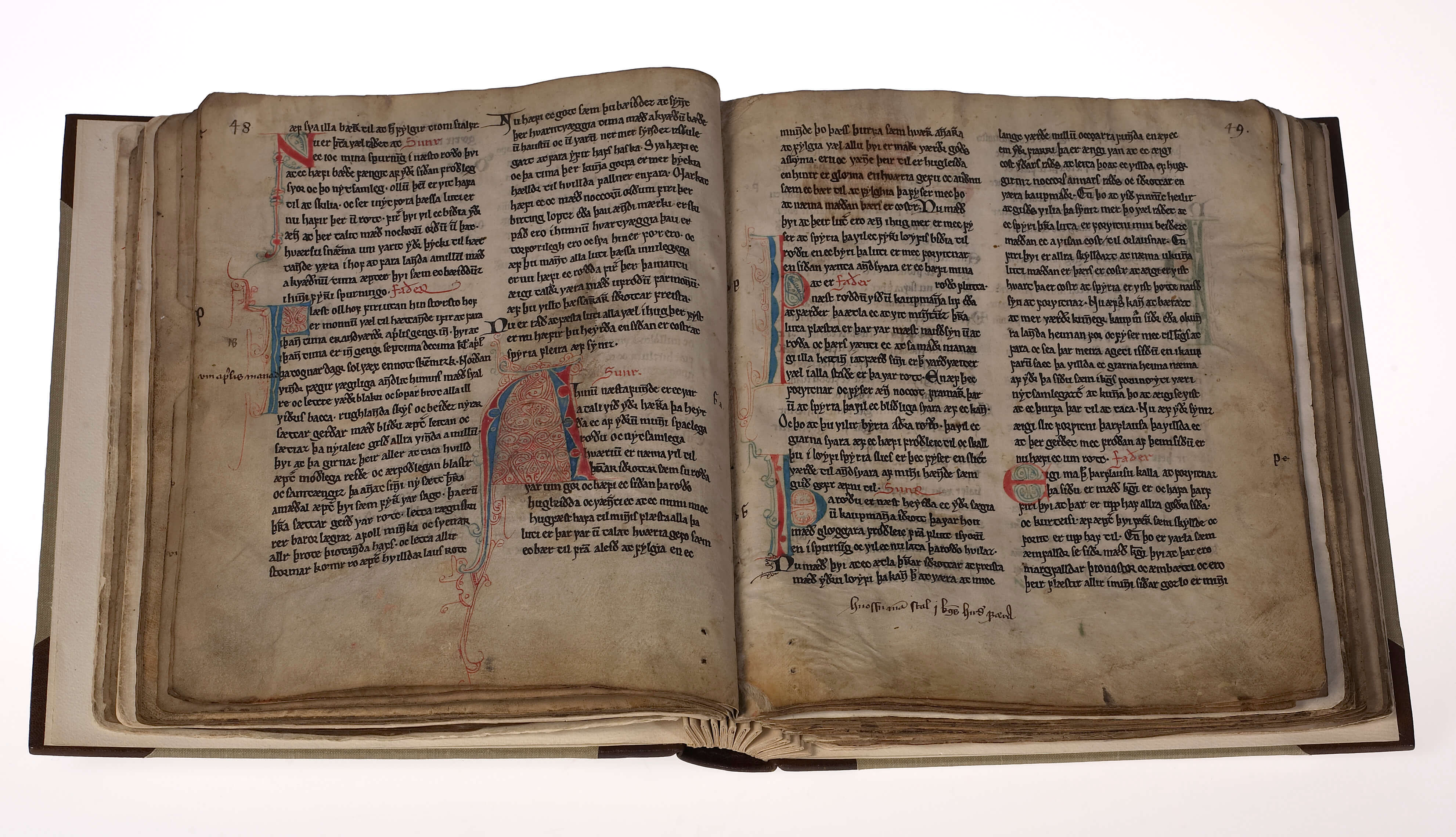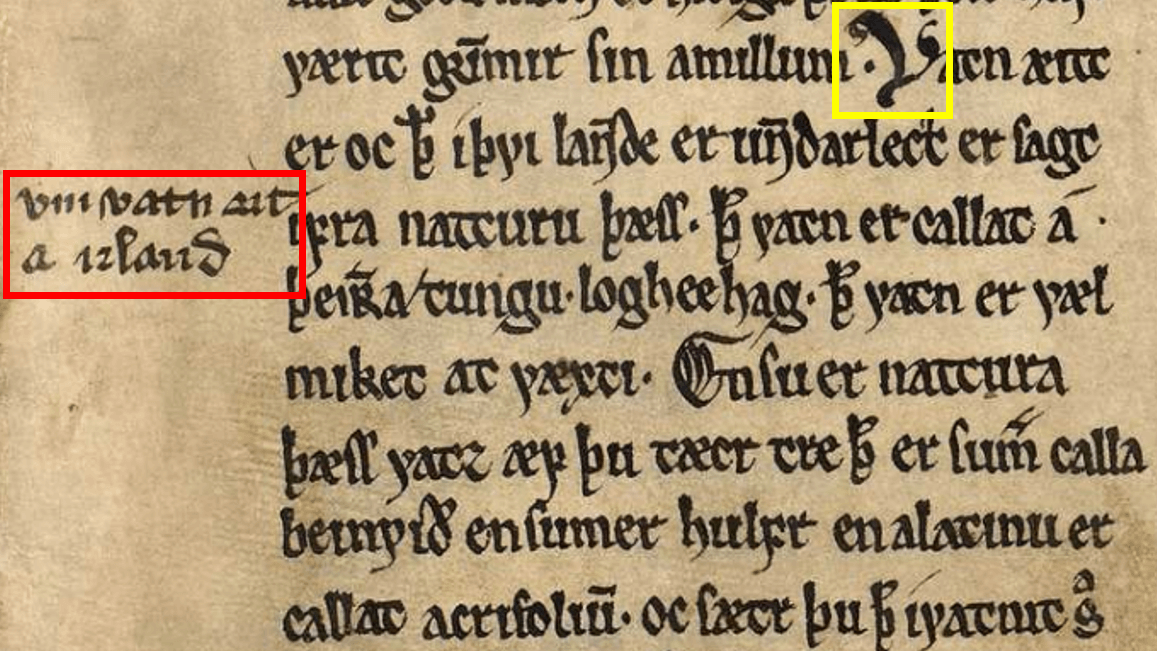Let me guide you through this! The interaction between scribe and readers in the main manuscript of Konungs skuggsjá
The oldest and most complete manuscript of the Old Norwegian Konungs skuggsjá, AM 243 bα fol., offers a treasure trove of knowledge on various subjects. This immense encyclopaedic and didactic work can be hard to navigate through, and thus AM 243 bα fol. bears witness to the intense interaction later readers had with this manuscript in finding their way through natural wonders, mirabilia, and lectures on the court.

The King’s mirror
Konungs skuggsjá or “The King’s Mirror” (in Latin Speculum regale) is an extraordinary historical and encyclopaedic text that is considered one of the main works of Norwegian mediaeval literature. The text addresses important issues of mediaeval society, such as the tasks of a merchant, the duties of a king and his court, and the role of the church and clergy.
These educational topics are presented to the reader through a knowledge exchange between a father and a son in the form of a dialogue. This format, also known as Lehrdialog (‘dialogue for learning’), is not an unusual one for this kind of instructional literary work in the Middle Ages; other examples include Elucidarius and the Book of Sidrach, both of which are also found in manuscripts in the Arnamagnæan Collection.
The Arnamagnæan manuscript
Konungs skuggsjá survives in around 60 manuscripts in both Old Norwegian and Old Icelandic, many of which are fragmentary. The oldest manuscripts of Konungs skuggsjá were written in Norway in the latter half of the 13th century, while the youngest are from Iceland from as late as 1800. Two of the oldest Norwegian manuscripts are housed in the Arnamagnæan Collection in Copenhagen: AM 243 bα fol. from ca. 1270 and AM 1056 IX 4to from ca. 1300.

The manuscript of AM 243 bα fol. is the main manuscript in Old Norwegian and the codex optimus (‘best manuscript’) of Konungs skuggsjá. Although no manuscript has been fully preserved and thus even this main manuscript shows several lacunae, it nevertheless contains approximately 80% of the text. As such, it presents the most comprehensive manuscript of this text.
Because of the lacunae, the main manuscript is missing the prologue, and the text starts with the words Goðan dag hærra minn (‘Good day, my lord’) on the second half of the first page. Whether the prologue was part of the original text at all is a topic of debate among scholars working with Konungs skuggsjá.
Several other sections are also missing from AM 243 bα fol. due to the lacunae. Some chapters have been lost completely, while others are fragmentary. Thus, the final part of the chapter on the tides and the course of the sun is missing, as well as the initial parts of the following chapter on the natural wonders of Ireland, the final part of the chapter on how to approach the king, the final part of the chapter on the judgements of King Solomon and the initial part of the following chapter on Solomon’s promises to Joab. All four chapter about Iceland, which cover discussions on whales and the kraken, wonders, volcanic fires and mineral springs, are missing in their entirety.

Comments, analysis, and guidance
Throughout the centuries, AM 243 bα fol. has been passed through many owners, with some leaving their marks on its pages. Notes, comments, and other markings in the margins, as well as in interlinear positions on the manuscript page, bear witness to a consistent consultation of the text and active reading, reflecting a rich history of engagement with the manuscript. Árni Magnússon played a significant role among the manuscript’s holders, adding valuable information, documenting its original state, and providing details on the mentioned lacunae to the manuscript.
The margins of AM 243 bα fol. contain fascinating additions made by readers, primarily in the 14th and 15th centuries. Some of these marginalia serve as helpful navigational aids, guiding readers through the text and allowing them to quickly transition from one topic to the next. Several marginal structuring devices are names or keywords taken from the main text (see e.g. fig. 2), while others offer brief summaries of specific passages, akin to titles (see e.g. fig. 3).

And there is even more to these guiding aids! Some of the comments and notes form a kind of collaboration between the author and later reader throughout time. These combined efforts to make the manuscript text more easily approachable operate on three distinct yet interconnected levels – textual, visual, and notational. Information structure on both a textual and visual level has gone through several editorial processes to complete a guiding framework for readers.
Ða er þar ænn vatn æitt miket
If we for example explore the Norwegian periphery, specifically the chapter on Ireland, we encounter these processes in the introduction of three lakes, each connected to miraculous happenings. The description of the wonders associated with these lakes follows a rhythmic pattern, employing a repeating formula that reads (in variants): Ða er þar ænn vatn æitt miket … (6v, col.a:27, ‘Then there is a large lake ...’). This repetition (marked by underlining in fig. 4b-d) catches the reader’s attention on a textual level, introducing new referents while maintaining familiarity with the overall topic. Meanwhile, visual cues such as initials accompany the introduction of these new elements (highlighted in yellow frames in fig. 4a-d).
While these devices were used when the manuscript was first written, later hands thoughtfully added short notes connected to the content, and with a similar repetitive angle for the introduction of the lakes in the margins (highlighted by red frames in fig. 4a-d).

|

|

|

|
The combination of these guiding devices eases the reader’s navigation through the manuscript text. A reader thus can manoeuvre through the pages by the means of several visual and textual markers – traces of editorial processes that have shaped this manuscript.
Topics
Contact
Juliane Tiemann (Ph.D., Nordic Philology) is Senior Academic Librarian at the University of Bergen Library.
Bibliography
Cardelle de Hartmann, C. 2007. Lateinische Dialoge 1200 –1400. Literaturhistorische Studie und Repertorium. [Mittellateinische Studien und Texte, 37]. Leiden: Brill.
Flom, George T. 1915. The Arnamagnean Manuscript 243 Bα, folio at Det Kongelige Bibliotek, Copenhagen. The main manuscript of Konungs skuggsjá in phototypic reproduction with diplomatic text. Urbana: The University of Illinois.
Holm-Olsen, Ludvig. 1952. Hándskriftene av Konungs skuggsjá: en undersøkelse av deres tekstkritiske verdi. (Bibliotheca Arnamagnseana 13).
Holm-Olsen, Ludvig. 1983. Konungs skuggsiá. 2. rev. ed. (1st ed. 1945). [Norrøne tekster nr. 1]. Norsk historisk kjeldeskrift-institutt: Oslo.
Johansson, K. & E. Kleivane. 2018. ‘Konungs skuggsjá’ and the Interplay between Universal and Particular. In: Johansson, K. & E. Kleivane (eds.), Speculum septentrionale. Konungs skuggsjá and the European Encyclopedia of the Middle Ages, 9-34. Oslo: Novus Forlag.
Schnall, Jens Eike & Rudolf Simek. 2000. Speculum regale. Der altnorwegische Königsspiegel (Konungs skuggsjá) in der europäischen Tradition. [Studia Medievalia Septentrionalia 5]. Wien: Fassbaender.
Tiemann, Juliane. 2023. Syntactic variation and information structure in Old Norwegian : an investigation of Konungs skuggsjá in AM 243 bα fol. Doctoral thesis. University of Bergen.
Contribute to Manuscript of the Month
Have something to say about one or more manuscripts in the Arnamagnæn Collection? Contribute to the column Manuscript of the Month to get your research out there! Write to Seán Vrieland (sean.vrieland@hum.ku.dk) for more details.
